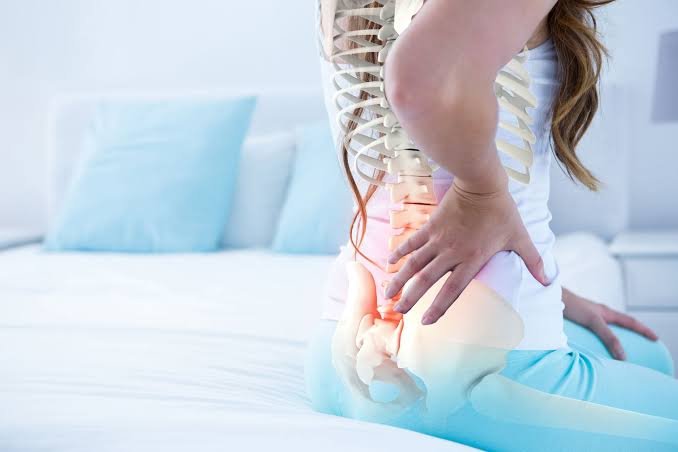
Lumbar spondylosis is a degenerative condition affecting the lower part of the spine, specifically the lumbar vertebrae. It results from age-related wear and tear of the intervertebral discs, facet joints, and surrounding ligaments. As the spinal structures deteriorate, they can lead to stiffness, chronic lower back pain, and reduced mobility.
Although common with aging, lumbar spondylosis can develop earlier due to lifestyle factors such as poor posture, sedentary habits, or excessive strain on the lower back. Degenerative changes can narrow the spinal canal (spinal stenosis) or pinch nerves, leading to radiating pain, numbness, or weakness in the legs. Chiropractic care offers a targeted, non-invasive approach to manage symptoms, restore mobility, and improve spinal function—without surgery or long-term medication use.
Several factors contribute to the gradual degeneration of the lumbar spine. The most common causes include:
Disc Degeneration: As spinal discs lose water content and elasticity with age, they become less effective at absorbing shock.
Bone Spurs (Osteophytes): The body may respond to disc wear by forming extra bone growths, which can narrow nerve pathways and cause pain.
Facet Joint Arthritis: The small joints between vertebrae become inflamed and stiff, reducing range of motion and causing lower back discomfort.
Repetitive Stress: Manual labor, frequent lifting, or poor lifting techniques place excess load on the lumbar spine.
Sedentary Lifestyle: Lack of movement weakens core muscles and accelerates spinal wear.
Obesity: Excess body weight increases pressure on the lower back, speeding up disc degeneration.
Postural Imbalances: Prolonged sitting, forward-leaning posture, or poor ergonomics strain the lumbar curve and surrounding structures.
Although spondylosis is often gradual, flare-ups can be sudden—especially after a wrong movement, long sitting, or lifting something heavy.
The symptoms of lumbar spondylosis vary in severity, depending on the level of degeneration and whether nerves are compressed. Common signs include:
Dull, aching pain in the lower back
Morning stiffness that eases with movement
Pain that worsens with prolonged sitting, bending, or standing
Radiating pain into the hips, buttocks, or legs (sciatica)
Numbness or tingling sensations in the lower extremities
Muscle spasms or tightness in the lower back
Difficulty standing upright or walking long distances
Loss of flexibility or reduced range of motion in the spine
In more advanced cases, patients may experience weakness in the legs, changes in gait, or bladder/bowel dysfunction—these signs may require urgent evaluation.
Our chiropractic treatment plans for lumbar spondylosis focus on reducing pain, improving spinal alignment, and helping the body function more efficiently. We use evidence-based, non-surgical methods tailored to each patient’s unique condition and lifestyle.
Your care begins with a detailed consultation, including history, daily activity review, and pain analysis.
We perform spinal mobility tests, neurological checks, and postural assessments. X-rays or imaging may be recommended to evaluate disc space, bone spurs, and vertebral alignment.
Targeted adjustments are performed on the lumbar spine to correct misalignments and restore joint mobility.
These gentle manipulations reduce nerve irritation, promote healing, and relieve muscle guarding around degenerative joints.
In cases with disc bulges or nerve compression, we may incorporate mechanical or manual spinal decompression.
This creates space between vertebrae, relieves disc pressure, and reduces nerve pinching—especially helpful for sciatica-like symptoms.
Tight muscles in the lower back, hips, and glutes often develop due to chronic postural compensation.
We use deep tissue techniques, myofascial release, and stretching to relax muscles and improve flexibility.
A strong core is vital for spinal support. We prescribe simple yet effective exercises to strengthen the abdominal, gluteal, and lumbar stabilizer muscles.
Postural coaching helps correct sitting, standing, and sleeping positions to reduce spinal strain in daily life.
We support your recovery with practical advice on sleep posture, movement patterns, lifting techniques, and anti-inflammatory dietary tips.
Supplements like omega-3s, glucosamine, or turmeric may be recommended to support joint health and reduce inflammation.
Patients with lumbar spondylosis often describe significant improvements in flexibility, posture, and energy levels after chiropractic treatment. Many report reduced morning stiffness, improved walking ability, and better sleep quality. Over time, regular care helps them regain confidence in movement and reduces flare-ups or dependence on medications. We focus not just on short-term relief but long-term spinal wellness.
Lumbar spondylosis doesn’t have to mean a life of constant back pain or activity limitation. With gentle, personalized chiropractic care, you can reduce inflammation, support healing, and restore better spinal mechanics—naturally and effectively.
Whether you’re struggling with stiffness, radiating pain, or fatigue from chronic low back issues, we’re here to help you move better, feel better, and live better. Schedule your consultation today and begin your journey toward pain-free mobility and long-term spine health.
Yes, it’s safe when performed by trained professionals. We adjust with precision and use supportive therapies to reduce pain and promote healing without stressing fragile discs.
Initially, frequent visits may help manage inflammation and pain. Once stabilized, periodic maintenance visits help prevent relapse and support ongoing spinal health.
Spondylosis involves general degeneration of discs and joints, while a slipped (herniated) disc involves a specific disc bulging or rupturing. They can occur together and are both treatable through chiropractic care.
In many cases, yes. X-rays or scans help us understand the degree of spinal degeneration or misalignment, so we can plan your chiropractic care safely and effectively.
We also require basic blood tests such as Vitamin B12 (for nerve health), Vitamin D3 (for bone health), and HbA1c (to check sugar levels) especially if you have fatigue, slow healing, or other systemic concerns. These tests help ensure your body is in the best state to respond to natural healing.